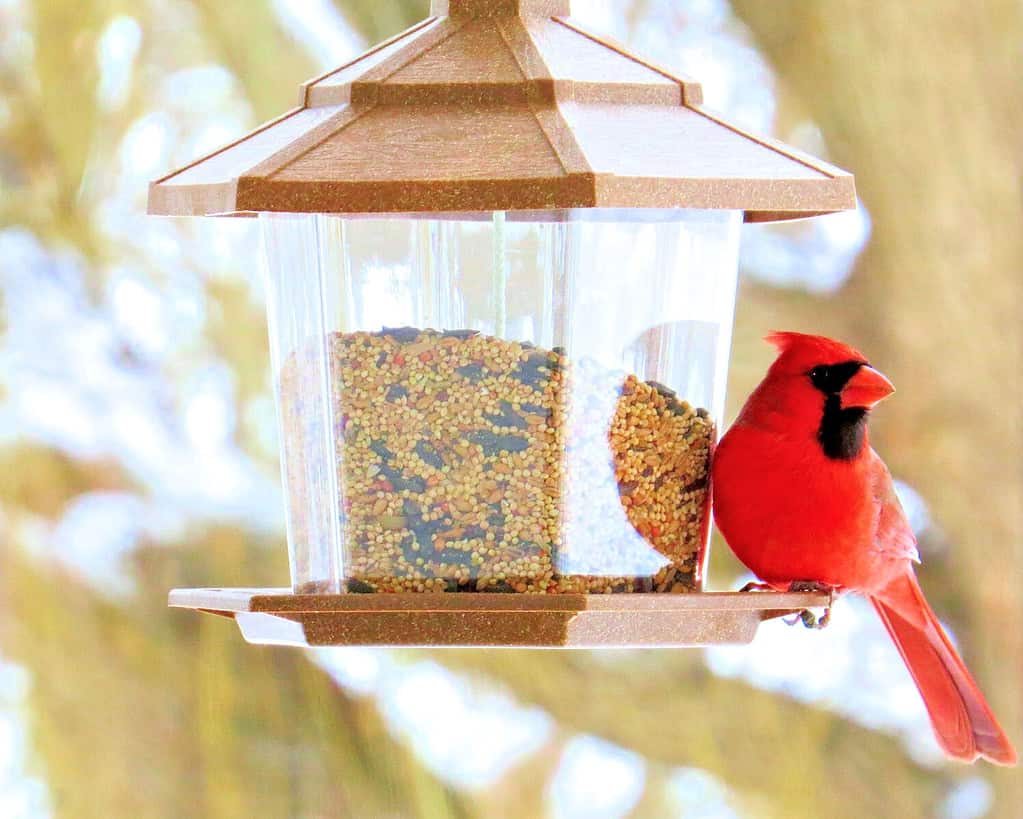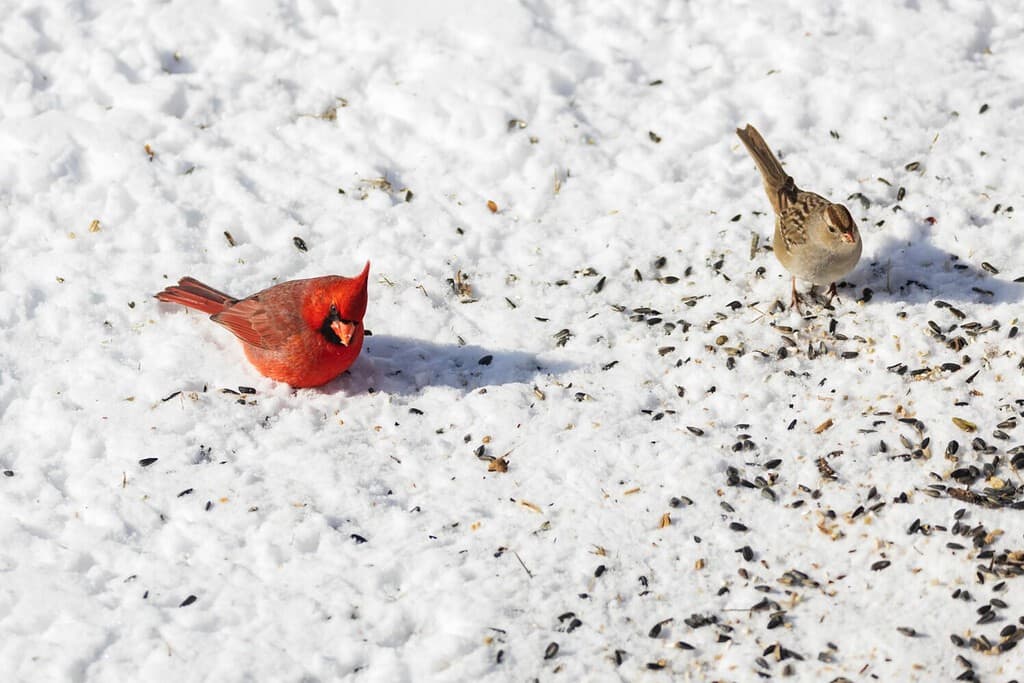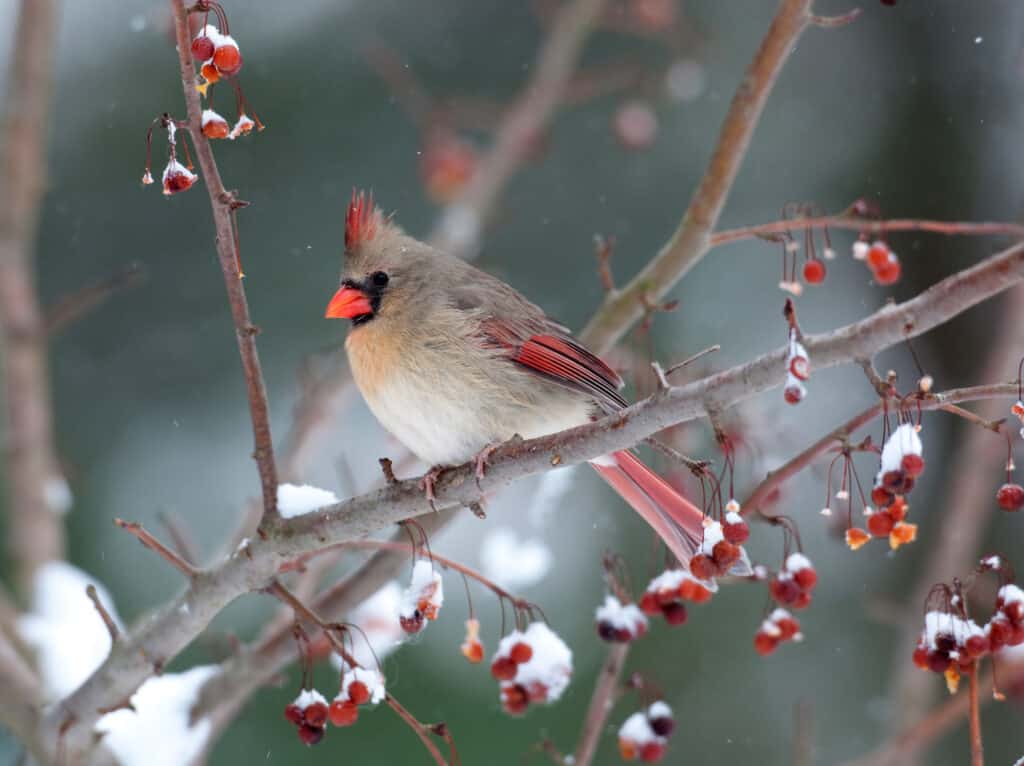When it comes time for the weather to grow colder in the northern hemisphere, it is not uncommon to find many of your backyard bird favorites becoming less and less coming. This is because many species will migrate during the winter, spending the coldest months of the year further south. However, such is not the case with the northern cardinal, which is a year-round species throughout much of North America.
During the coldest months of the year, rather than migrating to places that are warmer and more abundant in food sources, cardinals prefer to stay in their territory and survive off the resources available to them. In an effort to help these birds make the most of their winter, you may be interested in providing some extra food for them. Below, explore some of the most common food cardinals will eat from feeders in the winter, as well as learn about what they will find in nature.
Common Foods Cardinals Eat in the Winter

There are several common foods that cardinals may choose from in the winter, including those offered by humans.
©iStock.com/Hongkun Wang
Much of the cardinal’s diet is made up of insects, worms, and natural fruits like berries. However, during the winter, the food available to the cardinal becomes less readily available, especially in terms of plant-based nutrition. However, while fruit and berries may be less common in the winter, some plants still produce fruit during this month. Cardinals will spend the winter eating these, as well as whatever small insects they can hunt.
However, when available, cardinals will also rely on humans for food. Below, learn about some of the most favorable and common foods to add to your bird feeder during the winter. Not only will this help the local population of cardinals during the winter, but it can encourage them to visit your yard year-round.
Black Oil Sunflower Seeds
Cardinals are, overall, not a picky species. While they are not opportunistic enough to scavenge, they will often make do with what foods are available to them. However, when it comes to favored foods, cardinals typically tend to choose black oil sunflower seeds. In fact, black oil sunflower seeds are the favorite food of many passerine species! This makes them a great addition to your bird feeder year-round, regardless of what species you’re trying to attract.
Safflower Seeds

Different seeds can help keep cardinals healthy and energized during the colder months.
©MLHoward/Shutterstock.com
Like black oil sunflower seeds, safflower seeds are another favorite food of the northern cardinal. Not only that, but these seeds are an excellent source of many vital nutrients for cardinals and other birds. This can include protein, fat, and fiber—all essential in helping these beautiful birds best survive through the winter.
If you’re looking to attract other birds alongside cardinals during the winter, however, smaller birds may not eat these seeds. This is because the shell can be difficult for them to crack.
Suet
During the winter months, birds may need extra energy and, therefore, calories. Although suet may not be a food that birds find naturally in the wild, when added to your bird feeders, it can help quickly provide nutrients to a bird in the winter. Suet is rich in calories, as well as necessary nutrients, and there it is often easy to digest.
Peanuts
Cardinals greatly enjoy crushed peanuts. Although they sport powerful bills designed to break tough shells in the wild, peanuts can be difficult. As a result, providing crushed peanuts can help make this nutrient-dense food more readily available to hungry cardinals.
Mealworms

As omnivores, cardinals require both animal-based and plant-based food sources.
©Martina Sliger/Shutterstock.com
Cardinals are neither carnivorous nor herbivorous. Instead, they will eat both plants and other animals as available. During the winter, cardinals will naturally hunt worms and similar animals whenever possible. However, you can help provide necessary nutrients by supplying your backyard birds with mealworms.
Mealworms are rich in essential nutrients for healthy cardinals. This includes healthy fats and protein, along with fiber. Fresh mealworms are one of the best options for bird feeders. However, if this option is not available, you can soak dried mealworms to help provide another healthy choice for cardinals bunkering down for the winter.
Species Profile: Northern Cardinals

Northern cardinals are year-round residents of wherever they make their home.
©iStock.com/EEI_Tony
The northern cardinal (Cardinalis cardinalis) is one of the most iconic species in the United States. Males are known for their bright red appearances, featuring a black mask around their eyes. While females and juveniles of the species don’t share this bright red coloration, they do, however, share red features on an overall brown-grey appearance. Pairings are known for their pleasant behaviors, such as mate feeding, which often resembles “kissing.”
Northern cardinals, also known just as cardinals, can be found throughout much of North America. They are omnivorous, eating everything from insects to berries. Because they have many predators, they prefer safe, secure areas to eat.
The photo featured at the top of this post is © iStock.com/Hongkun Wang
Thank you for reading! Have some feedback for us? Contact the AZ Animals editorial team.







